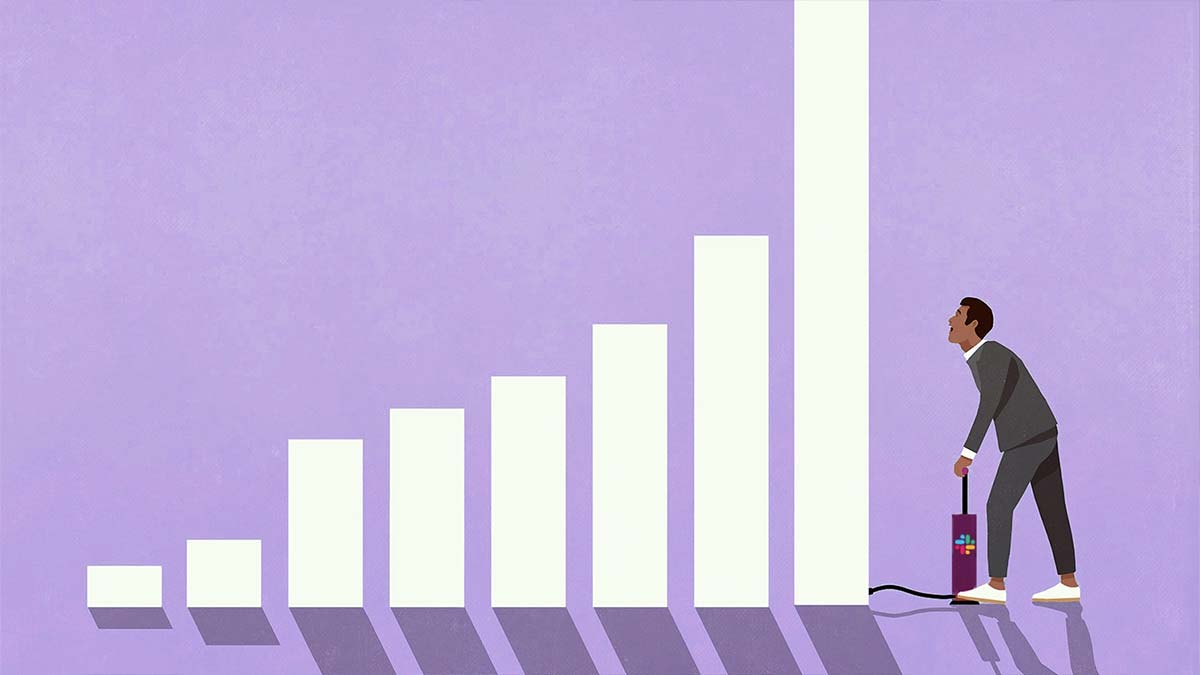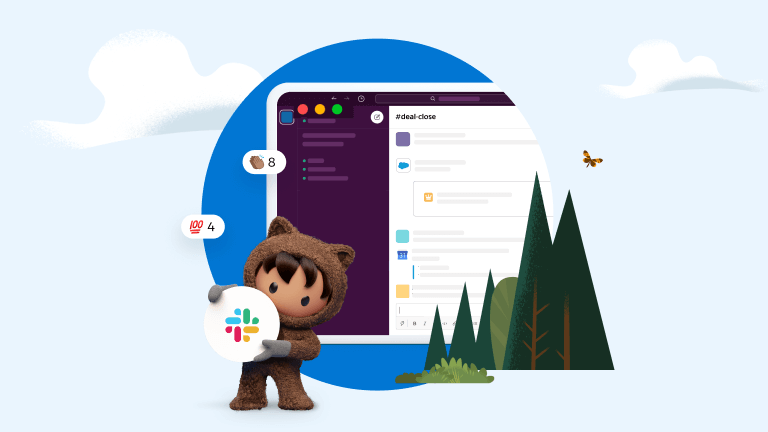Maximise sales team productivity with Slack and Sales Cloud.
How to exceed buyer expectations in today’s digital sales environment by aligning salespeople, processes, applications and customer data.
Chapter 1
Deliver a customer experience to remember.
Digital transformation has forever changed customer expectations. The loyalty of customers increasingly depends on whether or not their interactions with a company are easy and enjoyable. In today’s economy, it’s important to build lasting customer relationships that meet and exceed expectations. Doing that successfully requires tools that allow sales teams to maximise productivity and efficiency.
For instance, do reps have the visibility and access needed to help customers make a purchase or resolve an issue quickly? The less time reps spend looking for information, the more time they have to get to know the customer and build a long-term relationship.
Most sales reps, however, are working with too many tools, processes, and account updates, and too much customer data in multiple places. What’s more, key conversations are happening via phone, email, chat, LinkedIn, video, etc. It can all feel overwhelming, even for the most organised and experienced salesperson. The good news is sales leaders can now use a productivity platform for the entire sales cycle. This helps teams minimise context switching and administrative tasks so they can focus on delivering the best experience for customers.
Gartner reports that 61% of chief sales officers (CSOs) are already investing in new technology to support virtual selling. But CSOs need to go one step further and address all modern selling needs—virtual, digital and hybrid. They must bring salespeople, processes, customer data, communication technology, and strategic goals into one centralised productivity platform.
Slack is that solution, helping salespeople work with teammates in different time zones, prevent siloed customer data and promote collaboration on critical deals. But more importantly, it frees up time for reps to connect with buyers.
Chapter 2
It’s time to centralise selling.
Centralising selling means your sales team successfully wins together by using a flexible productivity platform. This approach allows reps and experts across the company to easily collaborate on accounts or opportunities, all while staying connected to a single set of tools, customer data and resources. Working from the same source of truth means sales teams can be more productive and efficient, giving them ample time to focus on customer needs.
According to a Gartner Trend Insight Report, having a “digital sales room” at the heart of an organisation’s sales tech stack helps enable virtual selling and promotes sales teams’ effectiveness.

Gartner expects that by 2025, 60% of B2B sales organisations will transition from experience- and intuition-based selling to data-driven selling, merging their sales process, applications, data and analytics into single operational practice.
A 2021 Forrester Consulting study echoed Gartner’s findings, saying that successful companies demonstrate a similar, singular operational alignment. The research and advisory firm listed several benefits, including:
- Having a single source of truth for customer data
- Working together daily on every major initiative and being well-aligned
- Having unified goals
- Using one system for all customer data across all departments, touchpoints, and inputs
Centralised selling might be the future of sales, but a fully aligned sales team can only begin by having the right tools in place.
Chapter 3
How Slack centralises team selling.
Slack makes it easy to bring what you need to close a deal into one place, improving efficiency and productivity. In Forrester’s “The Total Economic Impact of Slack for Sales Teams,” sales leaders and professionals around the world saw a 296% return on their investment in Slack after using Slack for three years.
In Slack channels, teams can assemble resources, teammates, processes and application data. Instead of scheduling a video meeting, sales teams in Slack can quickly start an impromptu huddle to work through issues in real time and resolve them faster, eliminating silos.
They can also work “async” to keep work moving along. If team members work in different time zones, and finding a meeting that works for everyone is impossible, members can record and post videos so everyone can review at their own convenience.
New team members get the context of the full account history when they join conversations, resulting in better collaboration. This is critical for salespeople starting on new accounts who need information fast to help prospects, and to close deals quickly.


Slack makes it easy to connect customers, employees, and partners with the data that powers digital workflows for greater productivity with less context switching.
Chapter 4
How using Sales Cloud and Slack together cultivates customer satisfaction.
Salesforce’s new State of Sales Report found that reps spend only 28% of their week selling, and 66% say they’re overwhelmed by using too many sales tools.
The power of using Sales Cloud and Slack together allows sales teams to be more productive and efficient by moving together faster, selling as a team, staying aligned and automating processes. This selling experience unifies teams in Slack and lets sales reps access all their tools, data and partners without neverending back-and-forths.
These Salesforce capabilities are available to Slack users now by downloading the Sales Cloud for Slack app (details in Chapter 6).
What Sales Cloud can do for teams.
Sales Cloud is a daily touchpoint for millions of salespeople across the globe, in industries ranging from manufacturing to media. Sales Cloud helps teams generate quality leads, manage opportunities through the sales pipeline and cultivate relationships with existing accounts with:
Account, opportunity and contact management.
Reps can spend more time building customer relationships and less time context switching with a complete, 360-degree view of customers that includes activity history, key contacts, customer communications and internal account discussions.Dashboards, automation and AI.
Sales Cloud users can move fast on deals with customised sales forecasting reports that require no coding. Teams can make great decisions without a lot of manual work, even as they grow and scale, with Sales Cloud’s powerful automation, data capture and insight generation—all available at both the admin and rep level.Pipeline, forecast and territory management.
Sales leaders can turn one-on-one status updates into coaching sessions as real-time changes in customer data occur. Users can get visibility into the pipeline and home in on promising deals with quick filters and out-of-the-box KPIs. Sales Cloud also offers tools that help teams territory plan and prepare for the future.
Chapter 5
How Sales Cloud and Slack can help sales teams win more deals.
Sales reps aren’t the only ones who win when teams strengthen alignment, eliminate silos, and use a productivity platform for real-time data. Customers also come out on top with a unified Sales Cloud and Slack solution.
Being able to easily connect, share feedback, deliver updates, and collaborate within and across organisations means any sales rep can solve customer questions and issues effortlessly.
Additionally, real-time data from Sales Cloud can be accessed, updated, shared or even created, directly from Slack. For example, when a channel that is connected to a Sales Cloud opportunity or account record is automatically created, the data from that record is automatically embedded in that channel. Sales teams can then interact with that data from Slack or Sales Cloud, and updates show up in both places in real time. This provides visibility to all channel members, helping teams stay aligned on deal movements. It also means reps spend less time code switching or updating data and views.
No critical updates fall through the cracks, and reps can move through the deal cycle faster, giving them more time to build memorable customer experiences.
There are currently three places in the customer journey offering a tight integration between Sales Cloud and Slack:
- Quick Record Management and Team Selling: Collaborate faster and sell smarter with the Sales Cloud for Slack app. Get notified about the right deals and easily update your Sales Cloud data to move business forward and close deals quickly. Get notified about the right deals and easily update your Salesforce data.
- CPQ to Quote: Accelerate approvals to realise revenue sooner. Upon submitting a quote for approvals in Salesforce, approvers can view details and take actions in Slack while submitters can see status changes in real time.
- Partner Relationships: Reimagine partner collaboration that drives channel growth by bringing partners right into the flow of work in Slack. Collaborate on deals, review opportunities and complete timely tasks. This solution will be available June 2023.
Chapter 6
How to get started.
Want to begin working in your productivity platform today? Here’s how:
- Be a Salesforce customer and subscribe to a Slack plan (each platform is sold separately).
- Get started with the free Sales Cloud for Slack app, available in the Slack App Directory, and keep an eye out for a new, unified solution coming summer 2023.
- Create internal Slack channels for collaboration.
a) Announcements: Start by setting up a sales team channel for members to share updates and swap intel. This is the team’s virtual water cooler.
b) Account planning: Create channels dedicated to specific accounts, known as account channels. This is where an account team (account executives, specialists, sales leaders and so on) can strategize together.
c) Deal rooms: Set up opportunity channels for your accounts, where finance, legal and deal support can help the sales team push deals across the finish line.
- Connect with customers and external partners. With Slack Connect, outside partners and customers can access data, business processes and experts from the same workspace. Both your team and your partners can regularly check in, exchange feedback and update one another on progress or hindrances in dedicated and secure channels. Product experts can instantly be added to a channel, review the history of past conversations and address any customer questions.
- Add DocuSign eSignature. It’s a critical piece of closing deals for many salespeople —and now it can be done right in Slack. Just download the DocuSign eSignature for Slack app to send and sign contracts and other sales documents.
- Go async. Collaborating with your team members and customers requires a personal and flexible touch. With Slack, working async can take many forms. In each Slack messaging box, there is a camera icon. This is a feature called clips, where salespeople can record and send customers asynchronous audio and video messages, eliminating the need to schedule a meeting. Clips also benefits distributed teams because members can share and receive information at their convenience, no matter where in the world a colleague works. And for quick audio chats, there’s Slack huddles.
- Bonus: Add analytics. Salesforce customers can use Tableau Analytics in Sales Cloud. Tableau provides salespeople with data that makes it easy to analyse sales numbers, find insights and use its predictive power to target the right prospects. This functionality can be added to Slack with the Tableau for Slack app. The app also lets Slack users see snapshots of visualisations, with links back to Sales Cloud for further exploration.
Related Content

Blog
Virtual Sales Are Here to Stay — The Latest Research Tells Us Why

Blog
Why Slack Is a Sales Team's Secret Weapon to Growing Revenue

Report
State of Sales Report
More Resources

Article
8 Sales Productivity Pitfalls (and Steps to Avoid Them).

Product
Drive productivity with all-new Slack integrations for Customer 360.

Demo
Sales Cloud Demo.
Do you have questions? We help you on your way.
Ask about our products, prices, implementation or anything else. Our experts are ready for you.













